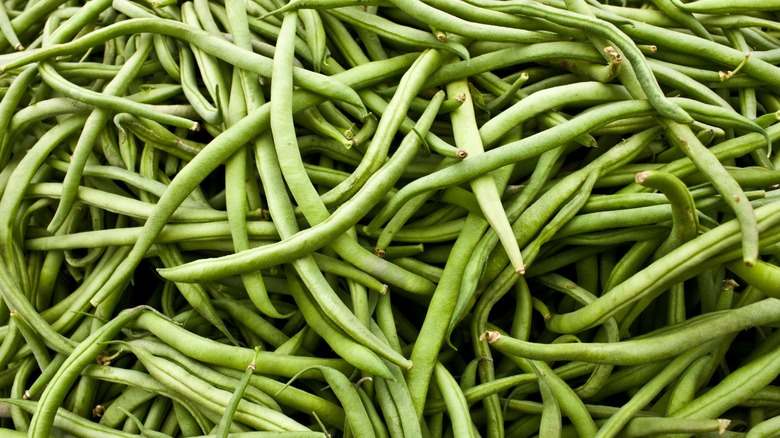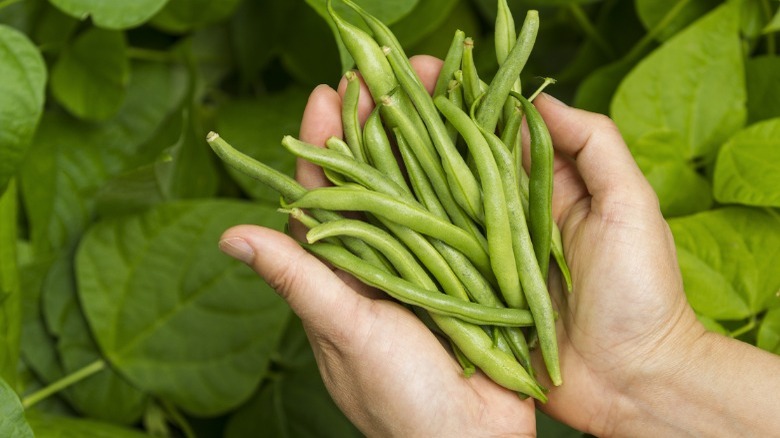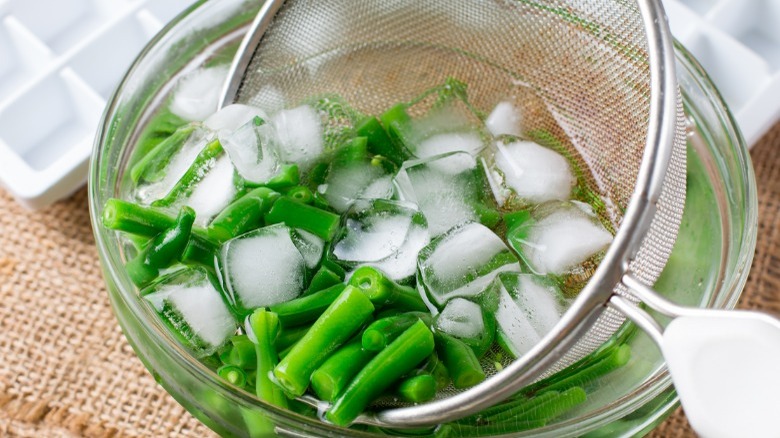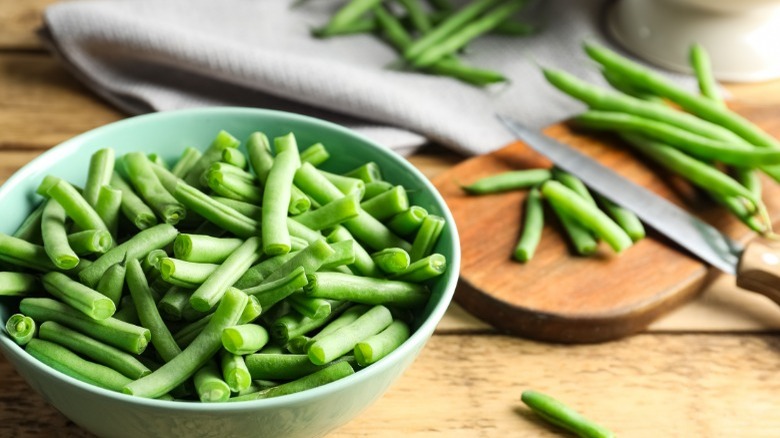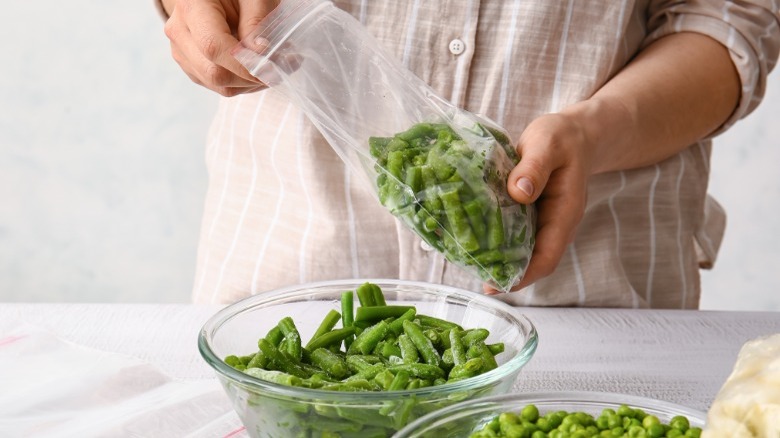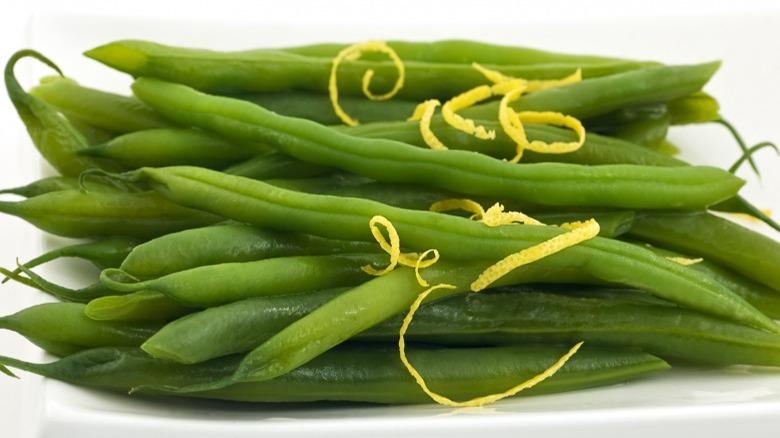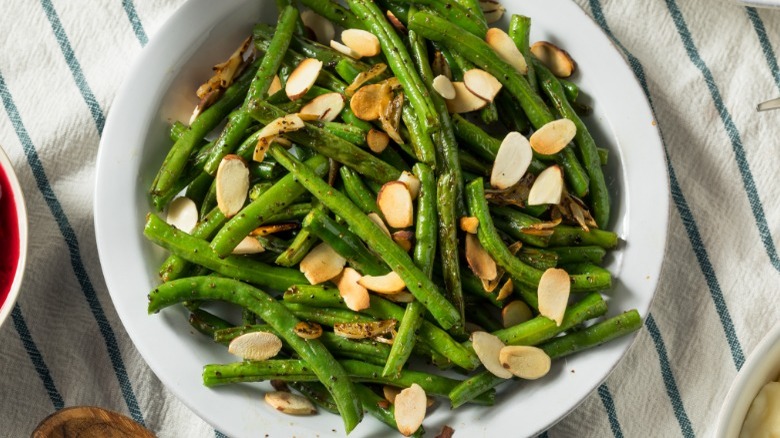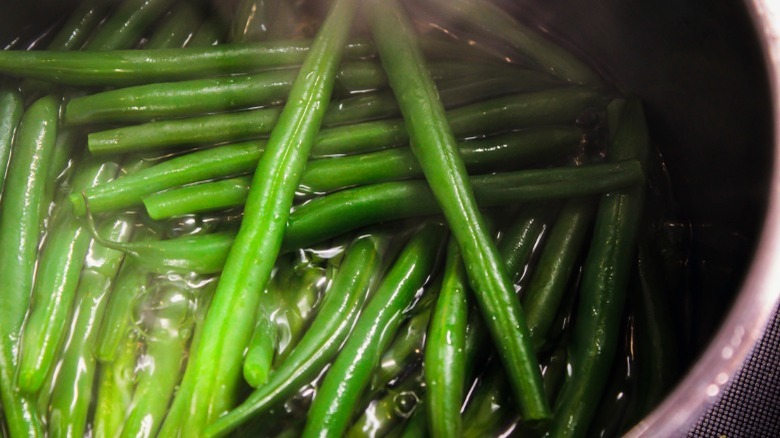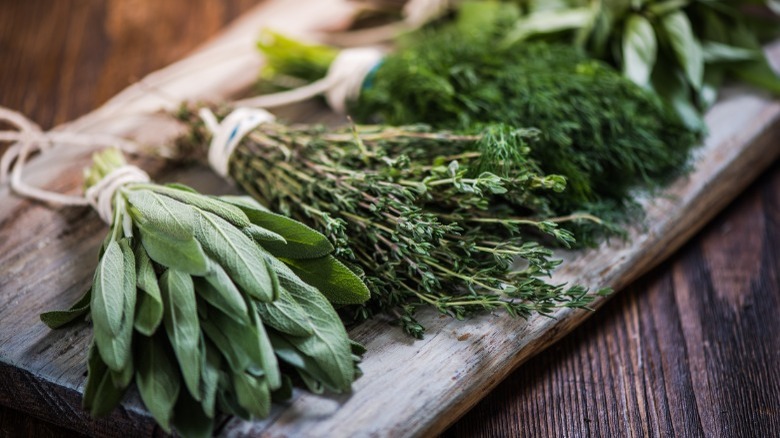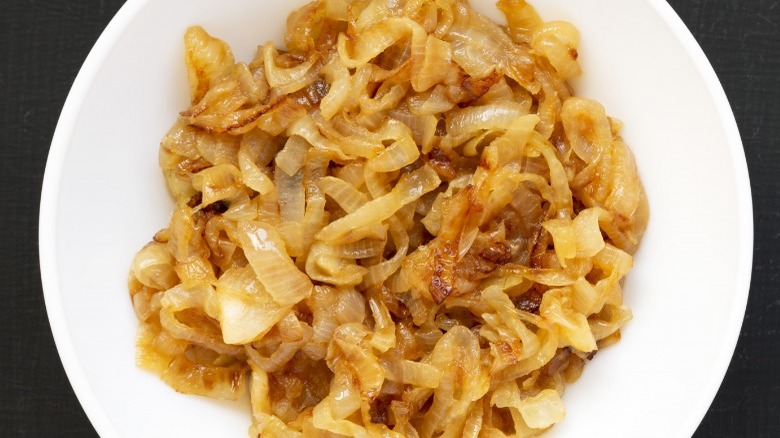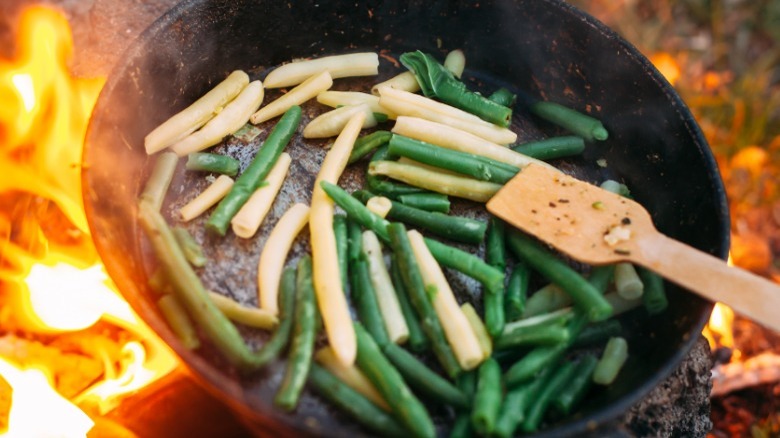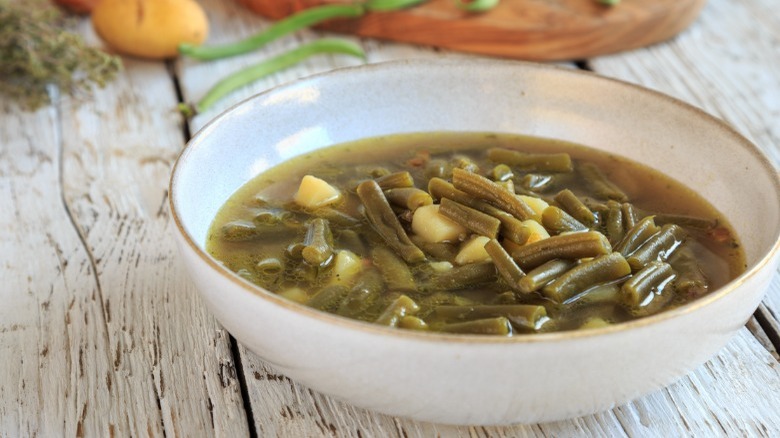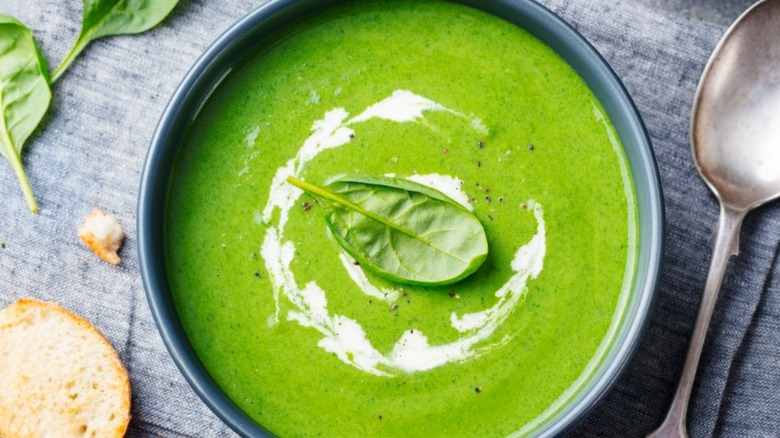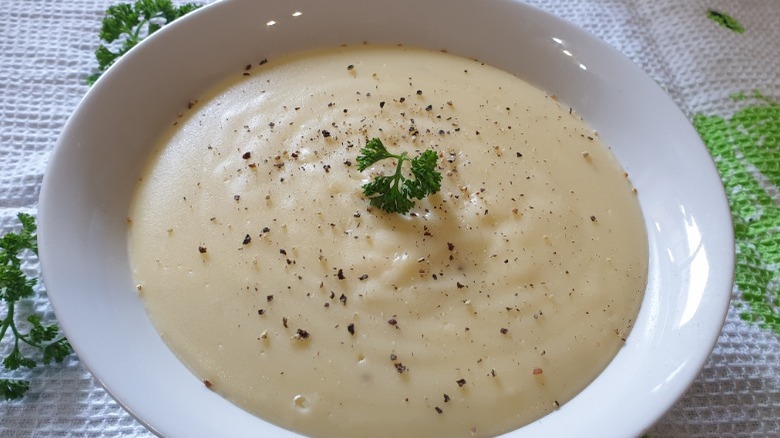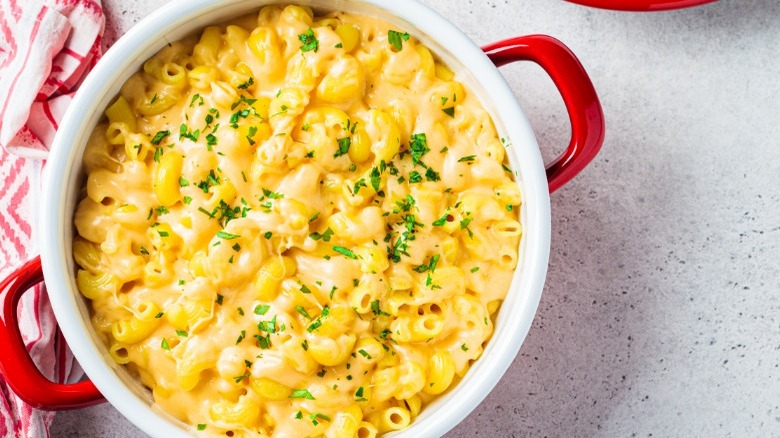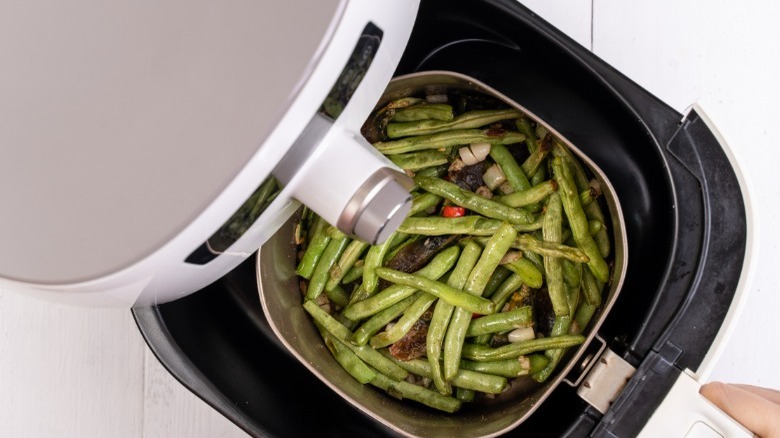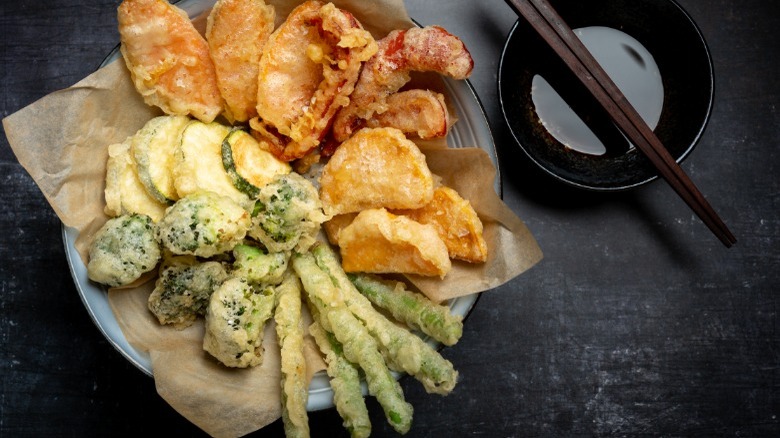17 Tips You Need When Cooking With Green Beans
If you take a peek into any American kitchen, there's a good chance you will find green beans in some shape or form. While freshness reigns superior through the growing season, there is something to be said about the quality of frozen varieties, too. We won't rank on canned versions either because despite the displeasing texture (and color), a can of green beans holds lots of nutritional value. In fact, green beans offer plenty of vitamins and minerals, are heart-healthy, and contain protein, which is excellent news for anyone on a plant-based diet (via Healthline).
The thing about green beans, though, is that this humble veggie has a lot more potential than one might think. We all love the green beans baked into a bubbly hot casserole, and most of us know about trimming essentials. But beyond standard details, we have a list of 18 tips you'll love to have stored in the back of your noggin next time you whip up a batch.
Keep them fresh
Green beans are well known for their satisfying crunch factor when enjoyed raw or even steamed just right. You won't get that with the canned varieties, so if you appreciate your veggies al dente, we recommend always sticking to the fresh ones in the produce section.
The only issue with buying fresh veggies is ensuring that they stay fresh. Green beans typically last up to a week in the fridge if stored properly. That means keeping them in a sealed food container or baggie and away from foods like bananas and tomatoes.
If you are fortunate enough to have a green thumb, you already know how overwhelming (yet gratifying) harvesting season can be. If you find yourself with too many green beans to enjoy before they go bad, you can always blanch them before storing them long-term.
Always blanch and shock before freezing
Blanching your green beans is an essential step to ensuring quality freshness. Let us explain. Blanching refers to adding fresh vegetables to a pot of boiling water, then letting them cook for a few minutes. Shocking refers to transferring those veggies into a bowl of ice-cold water to stop (or shock) the green beans from cooking any further. It's a step you cannot forget when freezing fresh bean pods.
So, if you have found yourself under the fortunate circumstance of having way too many green beans after harvest, you are in luck. Blanching your veggies will not only help retain that gratifying crunch, but your beans will also retain that gorgeous green hue too.
Start by creating an assembly line featuring a large stock pot filled with water, followed by a bowl of ice-cold water (literally throw cubes in) and then a paper towel-lined sheet pan to help dry them off. Seal them up tight and store them in the freezer for up to eight months.
Trim them in big batches
Before sprucing your string beans with a bit of butter, fresh herbs, or garlic, there are a few important steps needed to ready them before serving. Trimming is an essential step of the prepping process you'll need to take before cooking them. Some will say both ends need to be snipped, while others suggest only the branch end needs to go.
Here's the deal. The branched end is the end that was once connected to the rest of the green bean plant. That end tends to be a bit woody and fibrous, which is unpleasant to chew on even after it has been cooked. To avoid this, you undoubtedly need to trim this side of the pod. The other end does not need to be trimmed, but some choose to for aesthetics. The choice is yours.
Luckily, there is an excellent tip for trimming your green beans faster. All you have to do is arrange a small pile of green beans so that the stem ends are lined up and uniform. From there, chop off several tips at once using a sharp knife. You can do the same to the other side if you choose to trim both ends.
Freeze green beans before you cook them
The texture of cooked green beans matters tremendously. You don't want limp or mushy beans that taste as if you have just removed them from a can. Instead, you want green beans to maintain a bit of snap without being overly crunchy. Getting that perfect texture takes practice, sure, but preparing your green beans just right makes a world of difference too.
J. Kenji López-Alt says that freezing your green beans before cooking them works very similarly to blanching them, and it is the secret to bright and crisp green beans. Instead of blanching and shocking your string beans, you can quickly freeze them (after they have been trimmed) instead.
Interestingly enough, the technique works like blanching because the cells within the beans will break down and result in a nice texture. From there, you can let them thaw and then cook them up.
Use citrus zest and juice to your advantage
There are many ways to embellish those gorgeous little haricot verts, but some ingredients stand out. Because green beans already boast a bright, earthy taste, you'll want to find complementary components that match up just right. That's where a bit of citrus zest comes into play. This secret ingredient will majorly upgrade your string beans.
Lemon juice and zest work to lighten ingredients and cut down any greasiness that may be present in the vegetable. This will leave those pole beans with a lovely fresh taste that your taste buds will treasure. Beyond flavor advantages, cooking with lemons will bring loads of health benefits. Adding zest or juice to your meal could help support heart health, reduce cancer risk, and even improve your digestive health (via Healthline).
Considering how inexpensive they are, we recommend grabbing a bag at the grocery store each week. They can be used in most dishes, offer incredible health benefits, and provide a lovely flavor every single time.
Add nuts and seeds to green beans
From coating fresh filets of halibut or trout to topping cozy casseroles, you'll find that toasty nuts can bring on a palate-pleasing crunch. In fact, you'll love using nuts as a breadcrumb substitute if you're looking to cut back on carbs.
When it comes to pole beans, there are plenty of nut and seed varieties that will add a depth of texture while also lending a satisfying flavor. If it is your first time adding nuts to green beans, we recommend starting with a fan-favored classic like green bean almondine. The timeless French recipe usually combines cooked string beans with a bit of butter, salt, and toasted slivered almonds.
Once you are officially hooked, you can move on to other types of nuts and seeds. Toasted sesame seeds with a bit of butter and a dash of soy sauce would taste lovely, and salted pumpkin seeds would give your beans a great fall flare. Otherwise, give Ina Garten's haricot verts with hazelnuts and dill a try. The combination is both unique and incredibly delightful.
Avoid a mushy mess
For some, mushy green beans are both familiar and comforting. If you grew up eating the famous thanksgiving side dish staple from the canned green beans, then the soft, soggy vegetable likely brings back a strange nostalgia that suits your taste buds in a way that only time can explain. We won't fault you for your taste bud recollections; everyone holds unique food nostalgia near and dear.
For many others, mushy green beans are a straight-up faux pas in the world of cooked vegetables. Luckily, when making green bean casserole, there is a way to avoid mushy green beans, which means ditching the canned stuff.
Par-cooking fresh green beans before adding them to a casserole dish are your golden ticket to a lovely (not so soppy) side dish. Because they will finish cooking in the oven, you'll be left with perfectly cooked green beans that won't end in a mushy mash.
Don't forget to add fresh herbs
There's a time and place for both dried and fresh herbs when it comes to cooking. While many say fresh ingredients reign superior to frozen or canned foods, we have to disagree for herbs.
There are several cooking implications that suggest dried herbs come in handy. For example, if you're working with soups, stews, and sauces with long-simmering times, always go for the dried stuff. Woody-stemmed herbs like rosemary, thyme, and sage also work well, especially when wrapped into a spice sachet. Not only will the potency of dried herbs work to seep in and marry just right, but you won't have to worry about fishing out wilted herb leaves.
Consider using dill, parsley, mint, or savory. Savory is a German herb that does a fine job of elevating green beans, thanks to its peppery taste or piney taste, depending on the variety you choose to use.
Garlic and onion elevate green beans
Garlic and onion are a classic duo that you'll find in a plethora of savory dishes, and for a good reason too. The two ingredients can be pretty potent when used raw, but that sharpness cuts down quite a bit when cooked down.
In fact, the two aromatic vegetables bring on a much-needed oomph of flavor when married and infused into dishes. When onions are cooked, you'll notice a subtly sweet and umami taste from the vegetable. Garlic works similarly. While it's incredibly pungent in its raw form, a gorgeous sweet and buttery flavor develops when cooked.
Just imagine what those two bulbed vegetables could do to the humble green bean. After a quick blanching session, we recommend finishing your green beans with a sauté, then tossing in some caramelized onion and garlic. Each bit of entangled onion and garlic strand will bring on an incredible boost of flavor to your green beans. Finish that with sea salt and fresh lemon juice, and you have a winning plate.
Sauté them in bacon grease
Another incredibly flavorful way to elevate your green beans comes with using your breakfast's leftovers. Instead of throwing out the bacon grease, we highly recommend you store it for a rainy day — and by a rainy day, we mean the day you plan to cook green beans.
The smoky, salty flavor of bacon drippings is simply unparalleled, and the fact that you are required to cook the bacon first to receive that tasty fat means you get double the deliciousness.
First, we recommend steaming or blanching your green beans to cook them partially. Then you have to finish them with a hot sauté featuring bacon grease. If you have too much bacon grease to use right away, consider freezing it in ice cube trays. This clever method to store bacon fat will extend the life of this precious cooking fat and allow you to have small servings on hand at any point you need it.
Wrap them in bacon
There's another way to give your green beans that briny bacon flavor you love without worrying about bacon grease. Instead, consider wrapping your string beans in bacon. The meatiness and oh-so-saltiness of bacon pair beautifully with fresh green beans.
Courtesy of recipe developer Jaime Shelbert from Wholly Nourished, the two ingredients create an aesthetically appealing side that your eyes and taste buds will adore. The colorfully adorned dish comes together by wrapping par-cooked string beans with partially baked bacon strips. The oven will provide the additional heat needed to finish off these little bundles. Before throwing them in, don't forget to sprinkle them with brown sugar and garlic topping.
Next time you plan on making a roast chicken or lovely baked salmon dinner, be sure to keep this recipe in mind. The subtly sweet and salty bacon packaged neatly around the vegetable will suit most protein or starchy suppers.
Don't add them to soup too soon
You have to love hot soups for their ability to warm you up and fill your body with plenty of wholesome ingredients. The thing about soup, though, is that there are lots of common mistakes everyone makes when making them.
Between forgetting about the use of acidic ingredients, to undercooking your ingredients in that bubbly broth, a lot can go wrong. Possibly one of the biggest mistakes when working with vegetables, like green beans, is adding them to the pot too soon.
Heartier root vegetables like potatoes or carrots are usually safe to go in towards the beginning, but most other veggies cook up quickly. So if you plan to add peas, cabbage, zucchini, or green beans, be sure to introduce them to the pot toward the end of your cooking time. Leafy greens like spinach and kale can be added in the last five minutes.
Strain vegetable purées made with green beans
Some green bean varieties are referred to as string beans due to the string running along the pod's seam, which is usually removed before cooking. Today, most types are stringless, but regardless, the vegetable remains a bit fibrous, especially when picked past its prime (via Gardening Know How).
If you make a fancy vegetable purée to embellish your plate or feed your little one, you might want to whip out your fine mesh strainer first. Stringy vegetables with outer shells, like green beans and celery, don't blend well, especially if you own a weak blender.
So, after blending as well as your blender can, you'll want to pass the puree through the fine mesh strainer before serving. The results will be silky smooth and delicious.
Don't forget the cheese
There is really no other way to put it; cheese makes just about everything taste better. For those with dairy intolerances, we so deeply feel for you. Cooked green beans love a good cheese hug, and there are several ways to make that kind of magic happen. You can try finishing your roasted green beans with a sprinkle of shaved parmesan cheese or a drizzle of hot beer cheese sauce over the top. Even a slice of sharp cheddar slapped over the top and melted will do wonders.
Either way, the ultra-umami flavor that cheese offers is impressive over earthy vegetables like green beans, and it provides a richness that you won't get with many other ingredients. In fact, if you're looking for more ways to eat more vegetables, adding some cheese usually does the trick.
Add cooked green beans to macaroni and cheese
Take that cheesy addition one step further and add green beans to your favorite cheese-filled casserole. Baked mac and cheese will take all sorts of additional ingredients to make it memorable. Some of the more obvious additions include bacon bits and bread crumb toppings, but there are much fancier additives like truffles that give the dish a lively appeal.
One less common addition is, you guessed it, green beans. While the add-in might seem a bit off, all you have to do is think about the famous Thanksgiving day staple, green bean casserole. Now add macaroni elbows and sub out the mushroom sauce for a rich cheese sauce, and bam, you have yourself one heck of a delicious meal.
Air fry them for quick cook times
We don't know about you, but we think there is one appliance that happens to shine amongst the rest, and it's the air fryer. Not only does it allow you to crisp up most foods the way hot oil does, but it does it with less hot oil. Impressive? We think so.
Green beans are one of many earthy ingredients that cook up in no time, thanks to that magical gadget. For the quickest side dish ever, toss your trimmed string beans in a bit of oil, then top them with salt and pepper.
Place them in your air fryer basket in a single layer, then air fry for about eight minutes or longer, depending on how you light them. Finish them with parmesan cheese or lemon juice and serve them with grilled fish or poultry.
Batter and fry them up
Have you ever heard of tempura? If not, we highly recommend you give it a try, whether you enjoy it at a restaurant or attempt to make it at home. The Japanese dish usually consists of battered and fried ingredients like shrimp and vegetables.
Broccoli, sweet potato, carrots, and green beans are all common foods that taste absolutely lovely when battered and fried, tempura style. If you're often looking for new ways to learn new cooking techniques, finding an authentic tempura recipe is a great place to start.
You'll appreciate the lightness of this fried dish while experiencing the joys of international cuisine. Nothing quite speaks to culinary arts the way diverse global cuisine does.
